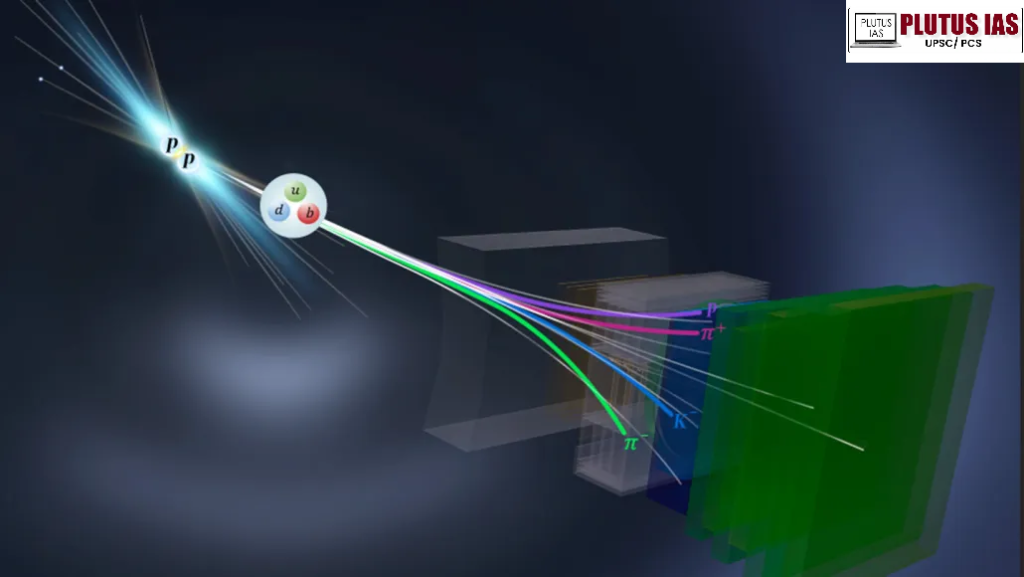Physicists at the Large Hadron Collider have discovered a new case of charge-parity (CP) violation, this time in baryons, particles like protons and neutrons. Previously, CP violation had only been confirmed in mesons. The study, focusing on lambda-b baryons, found a slight difference in how these particles and their antimatter counterparts decay, crossing the five-sigma threshold for discovery. This finding could help explain why matter dominates the universe despite the Big Bang producing equal amounts of matter and antimatter. While it doesn’t solve the mystery, it brings scientists one step closer to understanding the imbalance that shaped our universe.
What is matter vs Antimatter?
| Aspect |
Matter |
Antimatter |
| Definition |
Makes up everything in the universe |
The “mirror twin” of matter |
| Examples |
Protons, neutrons, electrons |
Antiprotons, antineutrons, positrons |
| Charge |
Normal charge (e.g., proton is +1) |
Opposite charge (e.g., antiproton is -1) |
| Interaction |
Stable and forms atoms |
Annihilates upon contact with matter |
| Annihilation |
Doesn’t naturally annihilate |
Matter + antimatter → Energy (gamma rays) |
| Mystery |
Dominates the universe |
It should have existed in equal amounts but is nearly absent |
| Research Focus |
Understanding why it dominates |
CP violation could explain the imbalance |
Recent developments in charge Parity Phenomena
1. First CP Violation in Baryons: LHCb observed CP violation in beauty-lambda baryons (Λb), marking the first confirmed instance in baryons.
2. Charm Sector CP Violation: The CMS experiment detected CP violation in charm quark decays, a crucial step in understanding matter-antimatter asymmetry.
3. Significant B<sub>s</sub> Meson Measurements: New data from LHCb and CMS provide strong evidence of CP violation in B<sub>s</sub> meson decays, refining theoretical models.
4. Neutrino CP Violation Studies: The NOvA experiment hints at CP violation in neutrino oscillations, which could impact our understanding of fundamental physics.
5. Matter-Antimatter Imbalance Insights: These findings contribute to explaining why the universe consists mainly of matter despite equal production of matter and antimatter in the Big Bang.
6. Five-Sigma Discovery Threshold Crossed: The LHCb results on Λb baryons met the statistical requirement for a scientific discovery, solidifying the findings.
7. Refinement of the Standard Model: CP violation studies help physicists test and refine the Standard Model, potentially pointing to new physics beyond it.
8. Future Experiments & Theories: Ongoing and upcoming studies, including upgrades at the LHC and future neutrino experiments, aim to deepen our understanding of CP violation and the universe’s asymmetry.
Significance of this new discovery
1. Explains the Matter-Antimatter Imbalance: The universe should have equal amounts of matter and antimatter, but we see mostly matter. CP violation helps explain why matter dominated after the Big Bang instead of annihilating with antimatter.
2. First Confirmation in Baryons: Previously, CP violation was only observed in mesons (particles with one quark and one antiquark). Now, for the first time, it’s confirmed in baryons (three-quark particles like protons and neutrons), broadening our understanding.
3. Strengthens the Standard Model: The Standard Model of physics predicts CP violation but doesn’t fully explain why matter dominates. This discovery gives scientists new data to refine existing theories.
4. Opens the Door to New Physics: If CP violation in baryons behaves unexpectedly, it could hint at new physics beyond the Standard Model, such as new particles or forces.
5. Validates the Large Hadron Collider’s Capabilities: The LHCb experiment at CERN continues to push the boundaries of particle physics, proving its ability to make groundbreaking discoveries.
6. Guides Future Research: Scientists can now study CP violation in more types of particles, especially neutrinos and other undiscovered baryons, to find deeper answers. This is a big step toward solving one of physics’ gre
Conclusion
The recent discovery of CP violation in baryons is a groundbreaking step toward understanding the universe’s matter-antimatter imbalance. By confirming this phenomenon in particles like lambda-b baryons, scientists have expanded the scope of known CP violation beyond mesons. This finding strengthens the Standard Model while also hinting at possible new physics. It validates the capabilities of the Large Hadron Collider and opens doors for future research into neutrinos and other subatomic particles. While this discovery doesn’t fully explain why matter dominates the universe, it provides a crucial piece of the puzzle, bringing us closer to unlocking one of physics’ greatest mysteries.





No Comments